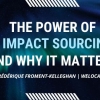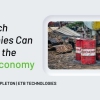Three Steps to a More Equitable RFP Process
Supplier diversity. These days, it’s more than a buzzword. It’s rapidly become a top priority for many organizations.
According to new data, a renewed focus and much-needed attention to supplier diversity is only going to pick up more steam. The annual 2021 Bonfire State of Public Sourcing Report reveals that despite a return to pre-pandemic project numbers in 2021, things for procurement teams aren’t exactly “back to normal.” As business ramps up, procurement teams are navigating new focuses, strategies and goals—including paying closer attention to ensuring equitable opportunity for small and disadvantaged businesses to benefit from new growth.
Sourcing goods and services from historically disadvantaged or marginalized groups, such as minority or women-owned businesses, or small businesses, has emerged as a priority in part due to the Biden administration. The administration has outlined intentions to “support small businesses and tackle inequities in the federal contracting system,” including tripling federal contracting goals for small, disadvantaged business enterprises (DBEs) by 2025.
The push for supplier diversity goes well beyond the U.S. Federal Government. Organizations such as the Royal Bank of Canada, Dell Technologies, and Unilever have each outlined the ways that they promote equality and inclusive economic growth through supplier diversity initiatives.
Besides using purchasing power to promote the overall social good, engaging diverse vendors is integral to fostering competition against the established “big players” in any industry—ensuring that the purchasing organization can secure more best-value contracts.
So, supplier diversity is important—but where do you even start? If your procurement team is small or you don’t already have an established supplier diversity program, it can quickly fall to the back burner. That’s why we’ve got you covered with three steps you can take to start awarding your RFPs more equitably now.
1. Eliminate Barriers That Discourage Bidding
Since historically disadvantaged businesses may have fewer resources, both in terms of headcount and budget, there may be inconsistencies in what is categorized as a barrier to entry for a business.
Let’s look at online bidding portals, for instance. The State of Public Sourcing Report found that eProcurement use in public agencies has increased by 38% since 2019, and vendors submitting bids through Bonfire’s eProcurement solution has increased by 55%. As more organizations adopt online solutions to post solicitations and evaluate bid submissions, it’s important to keep the vendor experience top of mind, especially for small or disadvantaged businesses. Ask yourself: Are there steps or processes that might create barriers for DBEs?
For instance, some online bidding portals operate on a pay-to-play model. This means that opportunities are hidden behind a paywall and vendors are required to pay a fee before even viewing the opportunity and supporting documents. This model disproportionately excludes diverse businesses and ultimately discourages them from bidding on your project.
To encourage a more diverse pool of vendors to bid on your opportunities, online bidding should be free for all vendors. Taking additional action to ensure that the system is easy to use and offers on-call support for suppliers will also lower the barrier to entry for disadvantaged vendors.
2. Track and Report Supplier Diversity Data
Tracking vendor diversity data gives buyers a quick and easy opportunity to increase visibility into the participation of diverse suppliers. As the saying goes—you can’t manage what you don’t measure. In fact, as new policies and government funding emerge to promote supplier diversity, this type of reporting is becoming a requirement for many agencies.
Choose an eProcurement system that does this work for you, with the capability to set vendor registration fields and easily collect information around a vendor’s status, such as a DBE, small business, non-profit and more. The 2021 State of Public Sourcing Report found that almost 10% of Bonfire users are already using registration fields to track vendor diversity. In the past year alone, that number has doubled. As supplier diversity continues to grow as a priority, and as more organizations introduce supplier diversity programs, that number is expected to increase significantly.
3. Get Opportunities in Front of More Vendors
Of course, if diverse suppliers don’t know about your opportunities, they can’t bid on them. One surefire way to get opportunities in front of more diverse vendors is casting a wider net through vendor invitations. After all, 66% of proposals come from vendors who have been invited by the purchasing organization.
Data from the State of Public Sourcing Report shows that from 2019 to 2021, the number of vendor invitations organizations sent out for each project increased by more than 200%, reaching an average of 451 invitations per project. This is great news, because it means purchasing organizations are making the most of the advantages that come with expanding the vendor pool. A higher volume of invitations means more competition in the market, including more diverse vendors, local small business vendors, fresh options beyond tried and true partners, and ultimately the best outcomes for your organization.
Additionally, more purchasing organizations are discovering the benefits of bringing on DBEs as subcontractors, and eProcurement systems are adapting to allow suppliers to flag themselves as subcontractors. Vendor invitations are a great way to ensure subcontracting solicitations are seen by small or disadvantaged suppliers who may have overlooked the opportunity because they weren’t necessarily the right fit as a prime contractor.
Supplier Diversity in Action
When it comes to eliminating barriers for your suppliers, tracking data and expanding your vendor outreach, procurement technology plays a critical role.
For instance, Great Lakes Water Authority (GLWA), a leading provider of water and wastewater services in the United States, wanted to launch a small business initiative that would reach out to small business suppliers and bring them into the bidding process. Their previously paper-based process, however, meant that buyers had a hard time getting out of the administrative weeds and make supplier diversity a priority. The bid submission process, which involved manually shipping paper documents, also became a point of frustration for many vendors.
By implementing an eProcurement solution, GLWA was able to manage competitive events and collaborate with the market directly through the platform. By streamlining previously tedious manual processes, GLWA had access to a more efficient method of engaging vendors, a broader vendor pool and better means of managing vendor relationships.
“[eProcurement] has been tantamount in helping us in our outreach to our small business community,” said Sonya Collins, Procurement Director at GLWA.
For more insights into how your peers are navigating supplier diversity and other priorities and strategies in 2021, download a free copy of the Bonfire 2021 State of Public Sourcing Report.









